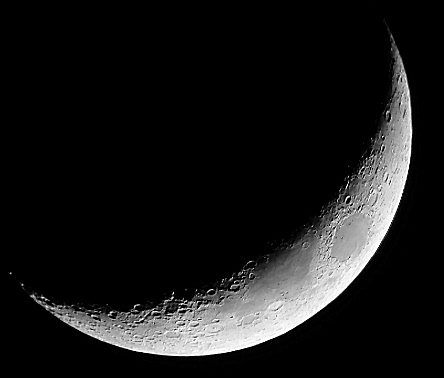This image of Saturn has been obtained after processing a 4 minutes video took with a Casio Exilim digicam. In order to avoid refractor chromatic aberration a Fringe Killer filter was used in combination with a 14mm eyepiece and a Barlow lens.
Archive for Casio Exilim EX-FS10
Saturn with a 6 inches refractor
Posted in Astrophotography with tags 150 mm, 6 inches refractor, achromatic, Astronomy, Casio Exilim EX-FS10, Fringe Killer, psp9, Registax, Saturn, Sky Watcher, Telescope on 2010/04/10 by computerphysicslabHommel crater
Posted in Astrophotography with tags 150/750, afocal, Asclepi, Casio Exilim EX-FS10, crater, digicam, Hommel, Moon, Nearch, Newtonian, no tracking, Paint Shop Pro, Photoshop, Pitiscus, point-and-shoot, shift-and-add, Telescope on 2009/08/10 by computerphysicslabHommel is a big crater with nice craterlets inside, a Clavius-style set, but smaller, measuring 76 miles (129 Km). It is located in the South-East area of the visible Moon face. This area is pledge of small craters. It is similar in appearance to the sand of a beach. Pitiscus, Nearch and Asclepi are some of its neighbors.
The picture was taken at 19 days of lunation, that is 4 days after full Moon. This is the best timing to get sharp images of the crater’s walls’ shadows. The image is an integration of 27 subframes, each one taken at 9 Megapixels single shots with point-and-shoot digicam Casio Exilim EX-FS10.

Jupiter occultation of 45 Cap
Posted in Astrophotography with tags 150/750, 45 Cap, afocal, Astronomy, Bright star, Casio Exilim EX-FS10, Jupiter, Newtonian, no tracking, occultation, Registax, shift-and-add, Telescope on 2009/08/04 by computerphysicslabJupiter occultation of 45 Cap tonight:
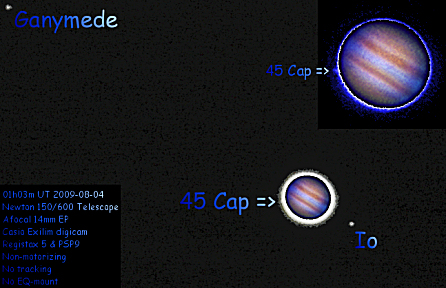
Jupiter with Exilim, 450d & Webcam
Posted in Astrophotography with tags 14mm, 150/750, afocal, Astronomy, Canon EOS 450D, Casio Exilim EX-FS10, Eyepiece, GRS, Jupiter, Newtonian, no tracking, Philips, Rebel XTi, Registax, shift-and-add, Telescope, ToUcam Pro, webcam on 2009/08/03 by computerphysicslabHere I have integrated my best images of Jupiter taken with 3 different cameras:
* Casio Exilim EX-FS10
* Canon EOS 450D (Rebel XTi)
* Webcam Philips ToUcam Pro
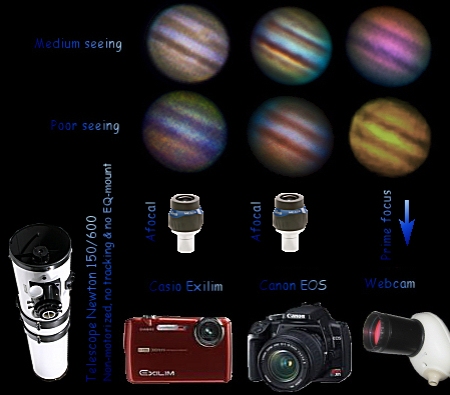
Jupiter post-processing
Posted in Astrophotography with tags afocal, Astronomy, Casio Exilim EX-FS10, good seeing, Great Red Spot, GRS, Jupiter, Newtonian, no tracking, Paint Shop Pro, Registax, shift-and-add, Telescope on 2009/07/29 by computerphysicslabI have been lucky tonight. Good seeing to see Jupiter. Using a small binoculars between the eyepiece and my eye I could spot visually Jupiter in high definition at an effective 450x magnification. That’s pretty good for a 150/600 reflector, isn’t it?
As you may appreciate in the following picture, the GRS (Great Red Spot) is clearly visible near the center of the planet. Several details are visible in the Jupiter’s bands. The image was obtained with a non-tracking Newtonian 6-inch telescope, a 14mm eyepiece, a Casio Exilim EX-FS10 digital camera that recorded 165 subframes. Registax 5 dealt with the alignment and stacking process. Dyadic Wavelets were applied to get contrast and details. PSP9 did the post-processing. The footage was taken exactly at 2009-07-28 03:33 UT.
Here several post-processing results are shown. The first one is that I like more.
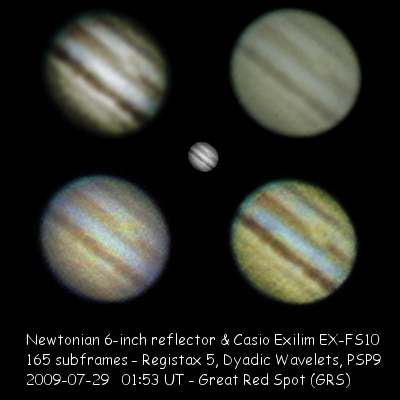
Jupiter, Europa & Ganymede
Posted in Astrophotography with tags afocal, Astronomy, Casio Exilim EX-FS10, Europa, Ganymede, Jupiter, no tracking, shift-and-add, Telescope on 2009/07/28 by computerphysicslabHere it is, Jupiter, Europa & Ganymede.

Jupiter’s galilean moons
Posted in Astrophotography with tags afocal, Callisto, Casio Exilim EX-FS10, Europa, Galilean moons, Ganymede, Io, Jupiter, no tracking, Registax, satellites, shift-and-add on 2009/07/22 by computerphysicslabGalilean moons are very easy to observe using some kind of instrument to get some magnification. With just a binoculars would be enough to spot the four moons of Jupiter. They are constantly rotating around Jupiter. Every day their relative distances and positions changes. Their names are Io, Callisto, Europa & Ganymede. They all have a similar size and brightness. When passing in front of the big planet, they cast a shadow over the gaseous surface of Jupiter. It is required a telescope to observe such events.
Here it is a picture I took tonight with a digital pocket camera through a 14mm eyepiece and a 150 mm newtonian reflector telescope with no-tracking system.
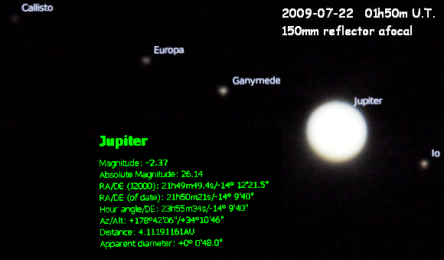
A bit better Saturn
Posted in Astrophotography with tags afocal, Casio Exilim EX-FS10, Dione, Meade Lightbridge 16", no tracking, Registax, Rhea, satellite, Saturn, Telescope, Titan on 2009/05/16 by computerphysicslabFortunately, yesterday was not cloudy and I could do further experiments with Saturn. Using a Barlow 2x and Casio Exilim EX-FS10 camera I filmed some videos at highest resolution through the big dobsonian telescope Meade Lightbridge 16-inch. Weather conditions were good. I did a better collimation than previous days, getting sharp focus from time to time. Stacking the frames with Registax 5 I got this resulting image:

In the left side of the image, it is visible a satellite of Saturn. It is Titan, with 9 magnitude. Over it, a bit at right there is almost visible another one, Rhea of magnitude 10. Visually it was observable another one aligned to Titan and Rhea, but it is not visible in the image. It was Dione with 11 magnitude.
Luckily this image shows the gap between foreside ring and its rear part. The image effective resolution according to my calculations is 1 arcsecond. Two cloud bands are visible one in the north hemisphere and the other in the south.
I would like to break the 1 arcsecond resolution barrier, but I don’t know if it is possible with this telescope. Theoretically it delivers a 0.3 arcsecond resolution because it has 400mm of mirror diameter.
Aristarchus crater
Posted in Astrophotography with tags afocal, Aristarchus, Casio Exilim EX-FS10, crater, Full Moon, Telescope on 2009/05/06 by computerphysicslabAristarchus is a rather peculiar crater. It is for me the most exciting pattern in the Moon. It is located over a weird squared area and there is an important valley near it, to its north-west. It is visible since now, 2 days before Full Moon.
The picture was shot tonight through a non-motorized 150mm (6 inches) reflector using high definition video capture with Casio Exilim EX-FS10.
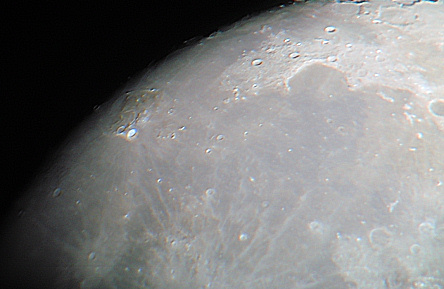
4.6 days lunation Moon
Posted in Astrophotography with tags 9Mpx, afocal, Astronomy, Binocular, Casio Exilim EX-FS10, Mare Nectaris, Mare Tranquillitatis, Moon, Registax, shift-and-add, terminator, Vixen 12x80 on 2009/04/29 by computerphysicslabTonight the Moon is crescent, and high in altitude. It is a good opportunity to record our natural satellite. Terminator is almost reaching Mare Serenitatis. Mare Nectaris (actually a gulf of Mare Tranquillitatis) is now fully illuminated and its Western border walls are clearly visible.
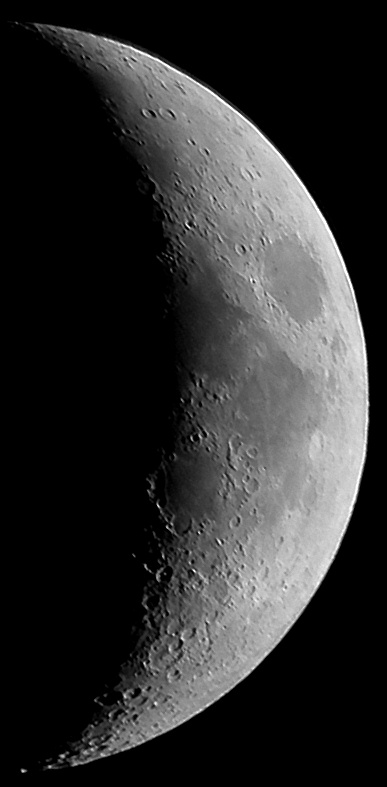
Tonight’s Moon
Posted in Astrophotography with tags 9Mpx, afocal, Binocular, Casio Exilim EX-FS10, Moon, Registax, shift-and-add, Vixen 12x80 on 2009/04/28 by computerphysicslabHere we have a 3.5 days lunation Moon. Mare Crisium is completely illuminated and some fine details may be seen, like small Swift crater (5 kms diameter). The image was a sum (Registax 5) of 10 subframes at 9Mpx using the Casio Exilim EX-FS10 and Vixen 12×80 binocular.
